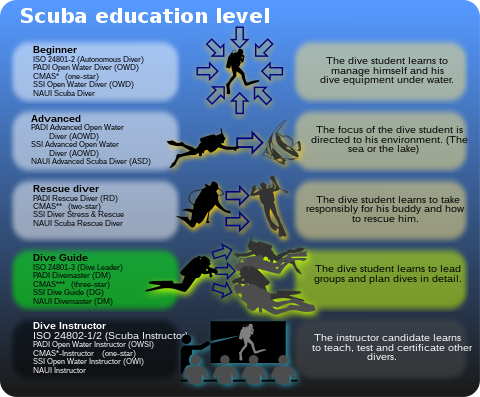

Recreational scuba certification levels are the levels of skill represented by recreational scuba certification. Each certification level is associated with a specific training standard published by the certification agency, and a training programme associated with the standard., though in some cases recognition of prior learning can apply. These levels of skill can be categorised in several ways:
Certification indicates that a diver was assessed as meeting the minimum requirements in the prescribed range of skills for that certification by an instructor registered by the issuing agency at the time of assessment. Most certification is not limited by time, and does not require periodical reassessment, or even that the holder maintains the minimum level of specified skills, but there are exceptions, which may be indicated by an expiry date on the certification card. Certification requiring periodic update usually indicates a requirement to re-register with the agency and payment of membership fees, but may also be associated with a requirement to provide evidence of skill retention. This is common for dive leadership certification where the holder is in a position of trust or legal responsibility to clients, where the agency needs to maintain a level of due diligence.
The history of recreational scuba certification is mostly the history of recreational scuba training, as the need for a method of identifying the competent diver was part of the reason for instituting formal training for recreational diving, following a number of fatal accidents involving untrained divers.
A diver training standard is a document issued by a certification, registration, regulation or quality assurance agency, that describes the prerequisites for participation, the aim of the training programme, the specific competences that a candidate must demonstrate to be assessed as competent, and the minimum required experience that must be recorded before the candidate can be registered or certified at a specific grade by the agency.[1] Training standards allow objective comparison between the training provided by various agencies and the competence indicated by certification or registration to the specific standard, though in most cases, training and competence may exceed the minimum requirement much of the time, and variation between newly certified divers can be considerable, partly due to differences in the training, and partly due to qualities of the candidate. Training standards may narrowly prescribe the training, or may concentrate on assessment of exit level competence, and allow recognition of prior learning based on various forms of evidence. To be useful, a training standard must be sufficiently specific to allow agreement on the requirements by most readers reasonably competent in the field, including the instructors, assessors, and learners who must use it, and any quality assurance personnel who may need to enforce it. A training standard may be associated with a specific code of practice referring to how the training should be carried out and the facilities required.[2][3]

This class of certification covers competence to dive within the scope of what is generally considered recreational open water diving, with no planned decompression obligations, a single air or nitrox breathing gas and relying on the buddy system or a dive leader for emergency management.
Most certification agencies provide diving skills training and certification beyond the Autonomous diver standard:
Skills which are not directly required for open-water diving using standard recreational scuba equipment and the protocols taught for basic recreational diving may be taught and certification issued attesting to competence in those skills. There are a wide range of specialist skills, which may be categorised in the following basic groups. In many cases there is some overlap of category, as when a type of activity requires specific equipment, or when equipment is required for safety in a given environment, such as navigation and redundant gas supply in penetration dives.
Training programs with certification are available in:
These certifications do not necessarily license the holder to work on life support equipment to be used by another person. In some cases the certification aligns with legislation. In some cases the certification is the de facto industry standard for competence in a specific jurisdiction.
The International Organization for Standardization has approved six recreational diving standards that may be implemented worldwide (January 2007).
The listed standards developed by the (United States) RSTC are consistent with the applicable ISO Standards:[15]
| (USA) RSTC Standard | ISO Standard | Alternative ISO Title |
|---|---|---|
| Introductory Scuba Experience | No equivalent | |
| No equivalent | Level One Diver [16] | Supervised Diver |
| Open Water Diver | Level Two Diver[16] | Autonomous Diver |
| Dive Supervisor | Level Three Diver[16] | Dive Leader |
| Assistant Instructor | Level 1 Instructor[16] | |
| Scuba Instructor | Level 2 Instructor[16] | |
| Instructor Trainer | No equivalent | |
| No equivalent | Service Provider[16] |
{{cite journal}}: CS1 maint: unfit URL (link)